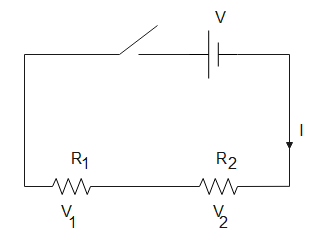
How do you calculate the voltage drop in a series circuit?
Answer
543.9k+ views
Hint: The difference in potential between two points in a circuit is called potential drop. Current flows from higher potential to lower potential. The potential drop is related to current and resistance by the ohm’s law. In series, current is the same while in parallel combination, the voltage drop is the same.
Formula used:
$R=\dfrac{V}{I}$
Complete step-by-step solution:
The voltage drop is the difference in potential between two points in a circuit. Its SI unit is volt ($V$).
The current in a circuit is the flow of charge through the circuit. Its SI unit is ampere ($A$). The resistance in the wire is the opposition provided to the current flowing in the circuit. Its SI unit is ohms ($\Omega $).
According to the ohm’s law,
$R=\dfrac{V}{I}$ - (1)
Here, $R$ is the resistance
$V$ is the potential difference
$I$ is the current in the circuit
The appliances can be connected in two ways in a circuit; they can either be connected in series combination or parallel combination.
In series combination, the appliances are connected one after the other while in parallel combination; the appliances are connected between two points.
In a parallel circuit, the potential drop on all the appliances connected in the combination has the same potential drop equal to the potential drop between the points.
In series combination, the potential drop on all the appliances in the combination is different. We can calculate the potential drop on individual appliances by calculating the same current through each and then by applying the ohm’s law for each.

For example in the circuit given above, when the switch is closed. A battery of $V\,volt$ is connected and the current flowing through the circuit and all elements connected is the same.
${{R}_{eq}}={{R}_{1}}+{{R}_{2}}$ [by series combination of resistors]
From eq (1),
$I=\dfrac{V}{R}$
We substitute given value in the above equation to get,
$I=\dfrac{V}{{{R}_{1}}+{{R}_{2}}}$
Therefore, the total current flowing in the circuit is $\dfrac{V}{{{R}_{1}}+{{R}_{2}}}$. Using ohm’s law, we can calculate the potential drop on each resistor. From eq (1),
$V=IR$
From the above equation, potential drop on ${{R}_{1}}$ will be-
${{V}_{1}}=\dfrac{V}{{{R}_{1}}+{{R}_{2}}}{{R}_{1}}$
Similarly, potential drop on ${{R}_{2}}$ is-
${{V}_{2}}=\dfrac{V}{{{R}_{1}}+{{R}_{2}}}{{R}_{2}}$
Also, $V={{V}_{1}}+{{V}_{2}}$
Therefore, potential drop in series is different for different appliances; therefore, we will have to calculate individual potential drops by applying ohm’s law.
Note:
The current is same in series but different in parallel combination. The equivalent of series combination of resistance is calculated by summing all the values in series. In parallel combination of resistance, the inverse of equivalent is the sum of inverse of all values in parallel. The combination of capacitors is analogous to resistors.
Formula used:
$R=\dfrac{V}{I}$
Complete step-by-step solution:
The voltage drop is the difference in potential between two points in a circuit. Its SI unit is volt ($V$).
The current in a circuit is the flow of charge through the circuit. Its SI unit is ampere ($A$). The resistance in the wire is the opposition provided to the current flowing in the circuit. Its SI unit is ohms ($\Omega $).
According to the ohm’s law,
$R=\dfrac{V}{I}$ - (1)
Here, $R$ is the resistance
$V$ is the potential difference
$I$ is the current in the circuit
The appliances can be connected in two ways in a circuit; they can either be connected in series combination or parallel combination.
In series combination, the appliances are connected one after the other while in parallel combination; the appliances are connected between two points.
In a parallel circuit, the potential drop on all the appliances connected in the combination has the same potential drop equal to the potential drop between the points.
In series combination, the potential drop on all the appliances in the combination is different. We can calculate the potential drop on individual appliances by calculating the same current through each and then by applying the ohm’s law for each.

For example in the circuit given above, when the switch is closed. A battery of $V\,volt$ is connected and the current flowing through the circuit and all elements connected is the same.
${{R}_{eq}}={{R}_{1}}+{{R}_{2}}$ [by series combination of resistors]
From eq (1),
$I=\dfrac{V}{R}$
We substitute given value in the above equation to get,
$I=\dfrac{V}{{{R}_{1}}+{{R}_{2}}}$
Therefore, the total current flowing in the circuit is $\dfrac{V}{{{R}_{1}}+{{R}_{2}}}$. Using ohm’s law, we can calculate the potential drop on each resistor. From eq (1),
$V=IR$
From the above equation, potential drop on ${{R}_{1}}$ will be-
${{V}_{1}}=\dfrac{V}{{{R}_{1}}+{{R}_{2}}}{{R}_{1}}$
Similarly, potential drop on ${{R}_{2}}$ is-
${{V}_{2}}=\dfrac{V}{{{R}_{1}}+{{R}_{2}}}{{R}_{2}}$
Also, $V={{V}_{1}}+{{V}_{2}}$
Therefore, potential drop in series is different for different appliances; therefore, we will have to calculate individual potential drops by applying ohm’s law.
Note:
The current is same in series but different in parallel combination. The equivalent of series combination of resistance is calculated by summing all the values in series. In parallel combination of resistance, the inverse of equivalent is the sum of inverse of all values in parallel. The combination of capacitors is analogous to resistors.
Recently Updated Pages
Basicity of sulphurous acid and sulphuric acid are

Master Class 12 Business Studies: Engaging Questions & Answers for Success

Master Class 12 Economics: Engaging Questions & Answers for Success

Master Class 12 English: Engaging Questions & Answers for Success

Master Class 12 Maths: Engaging Questions & Answers for Success

Master Class 12 Social Science: Engaging Questions & Answers for Success

Trending doubts
What are the major means of transport Explain each class 12 social science CBSE

Which are the Top 10 Largest Countries of the World?

Draw a labelled sketch of the human eye class 12 physics CBSE

How much time does it take to bleed after eating p class 12 biology CBSE

Explain sex determination in humans with line diag class 12 biology CBSE

Differentiate between homogeneous and heterogeneous class 12 chemistry CBSE




